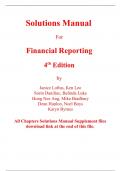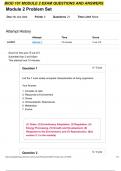Solutions Manual
For
Financial R
eporting
4th Edition
by
Janice Loftus, Ken Leo
Sorin Daniliuc, Belinda Luke
Hong Nee Ang, Mike Bradbury
Dean Hanlon, Noel Boys
Karyn Byrnes
All Chapters Solutions Manual Supplement files download link at the end of this file. Chapter1: Accounting regulation and the conceptual framework .
Chapter 1: Accounting regulation and the conceptual framework
Comprehension questions
1.What are the key sources of regulation in Australia for a listed company?
The key sources of regulation for a listed company in Australia are:
The Corporations Act, which is administered by the Australian Securities and
Investments Commission
Australian Accounting Standards and the Conceptual Framework , issued by the
Australian Accounting Standards Board
Australian Securities Exchange Listing Rules .
2.Distinguish between the roles of the FRC and the AASB.
Both the FRC and the AASB are involved in accounting standard setting. The AASB is
responsible for developing a Conceptual Framework and issuing accounting standards.
Another function of the AASB is to participate in and contribute to the development of a
global set of accounting standards. The FRC’s role in standard setting is essentially a broad
oversight function; it oversees the processes for setting accounting standards. The FRC’s
oversight function also extends to the auditing standard setting process, including monitoring
the effectiveness of auditor independence requirements in Australia.
The FRC appoints members of the AASB and approves its priorities, business plans, budgets
and staffing arrangements. The FRC determines the AASB’s broad strategic direction (e.g.,
the FRC directed the AASB to adopt International Financial Reporting Standards, such that
compliance with Australian Accounting Standards by profit seeking entities results in
compliance with IFRS). The FRC advises the AASB and provides feedback on policy
matters.
3.Discuss whether the financial reports prepared in accordance with the requirements
of Corporations Act must be audited and lodged with ASIC.
Part 2M.3 Financial Reporting of the Corporations Act set out the requirements on preparing
financial reports as well as auditing and lodging of the annual report with ASIC. Most of the
financial reports prepared by various reporting entities are required to be audited and/or
lodged with ASIC with some exceptions. Refer to Figure 1.1 for details.
4.Australia has adopted International Financial Reporting Standards since 2005. Does
this mean all accounting standards issued in Australia are the same as the IFRS
standards?
Most of the accounting standards issued by AASB complies with the IFRS standards. If there
are any variation from the IFRS standards they are clearly identified with the prefix “Aus” or
“RDR”. Since Australia adopted IFRS in 2005, technical issues on the IASB work program
are also included on the AASB work program. The AASB members and staff can identify
issues requiring consideration. Some of these issues can be referred to the IASB for
© John Wiley and Sons Australia Ltd, 2022 1.2 Solutions manual to accompany Financial reporting 4e by Loftus et al. . Not for distribution in full. Instructors may post selected solutions for questions assigned as homework to their LMS.
consideration and some can be addressed domestically. In fact the issue of an accounting
standard by the IASB would result in a corresponding and consistent standard being issued by
the AASB. The text of the international accounting standard may be modified to the extent
necessary to take account of the Australian legal or institutional environment and, in
particular, to ensure that any disclosure and transparency provisions in the standard are
appropriate to the Australian legal or institutional environment. This is often reflected in
modifications to standards for application by not-for-profit entities in Australia. AASB also
issued accounting standards that are applicable to Australian entities on issues that are not
covered by IFRSs. These standards are numbered with AASB 1xxx. 5.Explain the potential benefits and problems that can result from the adoption of
IFRSs in Australia.
The adoption of Australian Accounting Standards that are equivalent of IFRSs is essentially
an example of implementing a global set of accounting standards. It reflects the view that
doing so is, on the whole, in the best interests of the Australian economy. These benefits may
manifest in reduced cost of capital and reduced reporting costs for Australian companies that
seek finance in global capital markets. It also make listing on the stock exchange in Australia
more attractive to multinational corporations because Australian investors’ will have greater
understanding of financial statements prepared in accordance with IFRSs.
The problem that can result from the adoption of IFRSs in Australia is the ‘one size fits all’
approach used in the implementation of IFRSs in Australia. IFRSs were initially drafted to be
used solely by large for-profit entities. In Australia, however, they have been applied across
the board to all entities, including small and medium-sized entities, not-for-profit and
government entities. This resulted in unnecessary costs to the small and medium-sized
entities, especially in regards to satisfying the disclosure requirements in IFRSs. The AASB
has recently recognised this issue and has implemented a differential system — reduced
disclosure regime — whereby certain entities may not have to abide by the full disclosure
requirements of Australian equivalents to IFRSs.
6.What is the difference between Australian Accounting Standards and IFRSs?
While IFRSs are developed for application by profit-seeking entities, Australian Accounting
Standards are also applied by not-for-profit entities in the public and private sectors.
Accordingly, Australian Accounting Standards may include additional or different
requirements or exemptions for not-for-profit entities. These differences introduced by the
AASB can be easily identified in the text of the standards. For example, paragraphs added by
the AASB are prefixed with “Aus” while paragraphs deleted by the AASB are indicated as
“deleted by the AASB”. Australian Accounting Standards may also cover additional matters,
such as disclosure requirements on issues not covered by IFRSs (typically in a separate
standard).
7.Specify the objectives of general purpose financial reporting, the nature of users and
the information to be provided to users to achieve the objectives as provided in the
Conceptual Framework .
© John Wiley and Sons Australia Ltd, 2022 1.3 Chapter1: Accounting regulation and the conceptual framework .
The Conceptual Framework specifies the objective of general purpose financial reporting as
providing financial information about the reporting entity that is useful to existing and
potential investors, lenders and other creditors in making decisions about providing resources
to the entity. It adopts the ‘entity perspective’; that is, the entity is the object of general
purpose financial reporting, not its owners and others having an interest in it. In other words,
the focus is placed on reporting the entity’s resources (assets), the claims to the entity’s
resources (liabilities and equity) and the changes in them. Shareholders are seen not so much
as owners of the entity but merely as providers of resources to the entity, in much the same
way as lenders or creditors. Both present and potential shareholders, lenders and other
creditors are seen as constituting a single primary user group. This group makes decisions
about the allocation of resources as well as decisions relating to protecting or enhancing their
claim on the entity’s resources. Other potential user groups; for example, government and
other regulatory bodies, customers, employees and their representatives, are not the focus of
financial reporting. It appears odd that in times when environmental and social issues are of
great importance to society, and the desire for triple-bottom line reporting is growing, that
these issues are still ignored in the revised Conceptual Framework . However, this omission
may not be important as currently shareholders themselves are interested in environmental
and social issues and that provides incentives to entities to provide further information related
to those issues.
8.One of the functions of the FRC is to ensure that the Australian Accounting
Standards are ‘in the best interests of both the private and public sectors in the
Australian economy’. How might the FRC assess this?
The FRC is required under the ASIC Act to promote the adoption of international best
practice, provided that doing so would be in the best interests of both the private and public
sectors in the Australian economy. The success of this mandate may be assessed by
considering whether the Australian Accounting Standards, developed based on IFRSs,
contribute to the reduction in the cost of capital and reporting costs for Australian companies
that seek finance in global capital markets and improve the attractiveness to multinational
corporations of listing on stock exchanges in Australia. In doing so, feedback obtained via
various stakeholder mechanisms may be assessed. For example, stakeholder groups
represented on the FRC will be consulted regularly by the FRC member they have
nominated, and stakeholder views will be brought to FRC meetings, as appropriate.
9.Outline the fundamental qualitative characteristics of information that is useful to
users of financial statements.
The fundamental qualitative characteristics of financial information are relevance and faithful
representation.
Paragraphs 2.6 to 2.10 of the Conceptual Framework elaborate on the qualitative
characteristic of relevance. Information is relevant if:
•it is capable of making a difference in the decisions made by the capital providers as
users of financial information
•it has predictive value, confirmatory value or both. Predictive value occurs where the
information is useful as an input into the users’ decision models and affects their
expectations about the future. Confirmatory value arises where the information
provides feedback that confirms or changes past or present expectations based on
previous evaluations.
© John Wiley and Sons Australia Ltd, 2022 1.4






